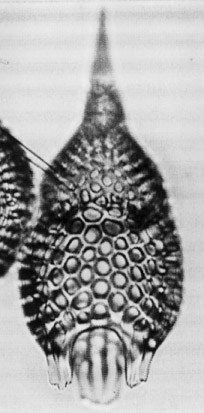 Podocyrtis
(Podocyrtoges) phyxis Sanfilippo and Riedel
Podocyrtis
(Podocyrtoges) phyxis Sanfilippo and Riedel Podocyrtis
(Podocyrtoges) phyxis Sanfilippo and Riedel
Podocyrtis
(Podocyrtoges) phyxis Sanfilippo and RiedelPodocyrtis (Podocyrtis) diamesa Riedel and Sanfilippo, 1970, p.533, (pars), pl.12, fig.6
Podocyrtis phyxis Sanfilippo and Riedel, 1973, p.531
Podocyrtis (Podocyrtoges) phyxis Sanfilippo and Riedel, Sanfilippo and Riedel, 1992, p.14
Similar in general form to P. diamesa, but rather stocky, with relatively larger, somewhat more inflated abdomen, and larger pores on both abdomen and thorax. No longitudinal ribs between pores (Sanfilippo and Riedel, 1973).
Total length (excluding horn) 240-385 µm; length of abdomen 105-245 µm; maximum breadth of abdomen 140-175 µm (Sanfilippo et al., 1985).
This species is distinguished from its ancestor P. (P.) diamesa by lacking longitudinal ribs on the thorax. The conical horn and thorax are relatively larger than in the superficially similar P. (L.) trachodes (which, in addition, occurs later, has a three-bladed horn, and has a very rough abdominal outline) (Sanfilippo et al., 1985).
This species has been found at only very few localities, apparently because of its short stratigraphic range, and it is therefore difficult to distinguish geographic from chronologic variability.
In some assemblages the thoracic outline is smooth and in others it is slightly rough, and the spacing of the abdominal pores varies a little (2.5 - 3 pore centers in 50 µm in DSDP 13A-1-1, 130-132 cm to 2.5 - 3.5 pore centers in 50 µm in DSDP 149-40-1, 80-83 cm). The lumbar stricture tends to be more distinct in younger assemblages (Sanfilippo et al., 1985)
This short-ranged, middle middle Eocene species is found only in the Caribbean, the eastern tropical Atlantic and the eastern tropical Pacific. Its evolutionary transition from Podocyrtis diamesa lies within the Thyrsocyrtis triacantha Zone. Its evolutionary transition to Podocyrtis ampla defines the base of the Podocyrtis ampla Zone.
There is little doubt that P. (P.) phyxis is descended from P. (P.) diamesa, and it seems likely that P. (P.) ampla is its descendant.